Intel’s Keynote at CES 2019: 10nm, Ice Lake, Lakefield, Snow Ridge, Cascade Lake
by Ian Cutress on January 7, 2019 7:45 PM EST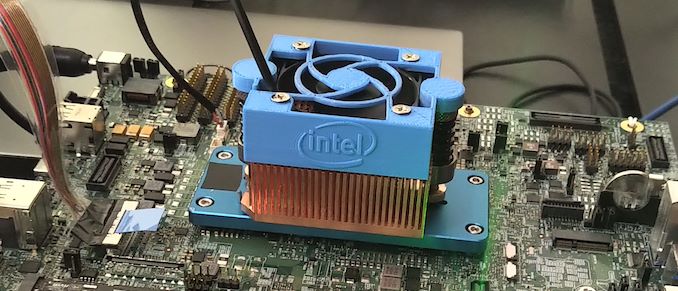
This year it seems that Intel is finally ready to talk about 10nm. After next-to-nothing on the subject at CES 2018, Intel is now talking about three new processor families: Ice Lake, Lakefield, and Snow Ridge. Despite the naming, it looks like Intel might be coming in out of the cold – to finally let it go – and roadmaps on upcoming products are being discussed.
It should be pointed out that Intel’s presentation did not mention anything about the company’s search for a new CEO, or any updates about Intel’s increased demand for its high-end Xeon processors. These are matters that the company will no doubt want to save for their earnings release later this month.
Stage 1: Consumer
Intel Client Group SVP Gregory Bryant took to the stage for Intel to announce two major hardware platforms and a new initiative in mobile computing. These were Ice Lake, Lakefield, and Project Athena.
Ice Lake: First Volume 10nm
One of the topics discussed at Intel’s Architecture Day, but under embargo until this week, is Intel’s vision for its first generation of 10nm-class consumer processors. We had already been given some details about Sunny Cove, the new Core design, as well as the updated Gen11 graphics architecture, but it will be Ice Lake that puts them both together.
Ice Lake, or more specifically Ice Lake-U it would appear, will be Intel’s first volume client processor on 10nm. Mobile processors are usually small, so it makes sense for Intel to use one for their first volume part in order to balance yields and costs – we’ve seen it before with 14nm, where Broadwell-U entered the market first. The base design from Intel looks to have four cores, eight threads, and 64 GPU execution units for graphics. Intel stated that they are driving the die area even more towards graphics under Gen11 in order to get more performance. This will be, according to Intel, its first standard (GT2-class) processor with 1 TFLOP of integrated graphics performance.
| Intel Ice Lake '4+2' For Notebooks | |
| Manufacturing Process | Intel 10nm |
| Cores / Threads | 4 / 8 |
| CPU Microarchitecture | Sunny Cove |
| Graphics Microarchitecture | Gen11 |
| Graphics Execution Units | GT2, 64 |
| TDP | 15W |
| Memory | LPDDR4X - yes LPDDR4X-3200 ? |
| Memory Bandwidth | 50-60 GB/s |
| Connectivity | TB3 over Type-C Wi-Fi 6 (802.11ax) with CRF |
| Image Processing Unit | 4th Gen |
Hardware wise, Intel explained that these processors would be using LPDDR4X. In a different segment of the presentation it was mentioned that the increase in integrated graphics (from a 24 EU configuration to a 64 EU configuration) required increasing memory bandwidth up to at least 50 GB/s. Intel did not disclose the specific memory frequencies supported, but with these bits of information I’d put LPDDR4X-3200 as the lower bound, as it offers 51.2 GB/s of bandwidth in dual channel mode. This is surprising, given that Intel is usually conservative with supported memory speed declarations – they still make a DDR4-2933 processor in their lineup – so jumping to 3200 would indeed be an unexpected shift for the company.
On the connectivity side, the chipsets for Ice Lake will enable Wi-Fi 6 (802.11ax) over the CNVi interface when an appropriate Intel CRF module is installed. Native Thunderbolt 3 is also expected, which of course operates over USB Type-C connections. Intel reworked the interface for camera support as well, adjusting the interface such that a MIPI-to-USB chip is no longer needed in a laptop bezel for webcam support.
Intel also mentioned software support, such as the new VNNI instructions, openVINO toolkit support, Cryptographic ISA instructions, and support for Overworld. These processors will have at least a similar security level as Cascade Lake, with hardware-enabled Spectre v2 mitigations.
Intel's Image Processing Unit, or IPU, is also upgraded to a fourth generation model. This part of the chip, according to Intel, now has a concurrent imaging pipeline for machine learning, and can support a single IR/RGB camera for login (e.g. Windows Hello). The IPU's power plane has also been tweaked, giving it more performance/power states so the system can save power as needed.
Ice Lake Designs: More Battery Life
Beyond the 10nm process node change, Intel also announced two additional ways in which it was improving battery life for Ice Lake-U systems. Firstly, the company described its efforts on platform innovation, saying they did a top-to-bottom analysis of what in the system is drawing power and finding ways to reduce it while still keeping performance. As a result, combined with the new ‘1W’ display technologies the company introduced at Computex in June, we’ve been told that optimized Intel devices should now be able to achieve 25+ hours of battery life.
Following a similar line of reasoning, Intel also reworked the board design specifications for thin and light devices. For a typical 12-inch laptop, Intel has freed up room for about 10% more battery capacity – going from 52 Wh to 58 Wh – thanks to reducing the total z-height and x/y dimensions of the motherboard. Interestingly, they've accomplished this without reducing the component count, bringing down the board size while retaining a given number of components.
Lakefield: Foveros Technology Coming Soon
At Intel’s Architecture Day in December, we saw a new class of chip from the company: a hybrid x86 CPU. It was a big announcement for two reasons: the first was that it featured both Core architecture and Atom architecture CPU cores, something that Intel had never done before. Ever since Arm's success with the similar concept of big.Little designs, we have been expecting Intel to come out with some products following this idea, but it was big news that this was finally the time. The second reason for it being a big announcement is that it used ‘Foveros’, Intel’s 3D active interposer technology that puts the cores and graphics on a chip on an interposer. However in a wrinkle from other interposer-based solutions, Foveros but puts the IO in the interposer (rather than using the interposer as a 'dumb' piece of silicon to route signals) all with through-silicon vias to make it work. A chip like this is much smaller in the x/y dimensions, as well as showcasing some very nice packaging technology.
Intel is giving that chip an official family name: Lakefield. The goal of designing Lakefield came from an OEM request to develop a chip that had 2 mW idle power draw, something much lower than current designs. Thus Lakefield was created. It uses a single Sunny Cove core, four Tremont Atom cores, and Gen11 graphics, all built on 10nm.
There have been questions about where exactly this chip will end up, or who even asked for it in the first place. Intel has stated that while a single customer put in the request, Lakefield will be available to all OEM partners if they want to design products around it. A lot of discussion has been held that this was an Apple request, and given Apple’s device portfolio, its volume of sales, and its desire to drive down power with optimized unique designs, the argument for Apple holds some water. But it doesn't sit right with me. This is more a low-powered chip, perhaps even lower power than the A12X in the iPads, so I don’t think Apple would want that chip in one of its MacBooks. (When we asked at architecture day, they said the chip could easily compete at the 7W TDP range, but I imagine it could go lower if needed.) Personally I’m of the opinion that it’s for the dual-screen Lenovo Yogabook. That device is super thin, super light, powers an LCD display and an eInk-like display, and doesn’t need that much power to do what it needs to do. But because it’s so thin there's limited room for battery cells, meaning that power consumption and the resulting battery life are all important, which is where Lakefield is likely to excel.
Intel announced that Lakefield was expected to be in production for products in 2019, which aligns with Intel’s commitment to having 10nm devices on shelves for the holiday season in 2019 (which would mean Christmas 2019).
Project Athena: Building Devices Ready for AI and 5G
As the single biggest force behind the PC ecosystem – and yet not a company that's selling hardware directly to consumers in most cases – Intel enjoys creating programs that try and push the market in certain directions. Depending on who you talk to, the Ultrabook program was either a big failure or a big success, but in the end it did give OEMs a chance to play with thin and light designs for a few years before the hardware gave users a good user experience and battery life. Project Athena is something slightly different, in that it will be a program for Intel and OEMs to work together to enable new experiences with technology coming in the next decade.
Terms like ‘5G’ and ‘Artificial Intelligence’ are only going to become more ubiquitous through 2020 and beyond, so Intel is jumping on it today. Current connectivity experiences for notebooks and laptops vary significantly, and AI implementations are either basic or removed from the local machine entirely and processed in cloud servers. With Project Athena, Intel is going to discuss with OEMs, with partners, customers, software developers, etc. what they need in order to enable these new terms to provide a good user experience. It isn’t just limited to 5G and AI, but we might see more requests for better AI toolkits, or power optimized designs for mobile connectivity, or more compute-related acceleration. It also extends to OEMs in their device design – if an OEM needs several cameras, or new biometrics, or supports more gestures, or new microphone array capabilities etc.
As this is a new program based in aspirational discussion followed by execution, it is unclear what the end goal will look like, only that the aim is around improvements to user experiences.
New 9th Gen Core CPUs
Intel also announced, briefly, that they will be releasing six new desktop 9th Gen Core processors, from Core i3 to Core i9. It did not disclose which parts or what the specifciations are, however we assume they will be available soon. We found the parts listed on Intel's ARK database just after the keynote and you can read our writeup here.
Also in the 9th Gen space, Intel said that the mobile 9th Gen Core processors will be available in Q2.


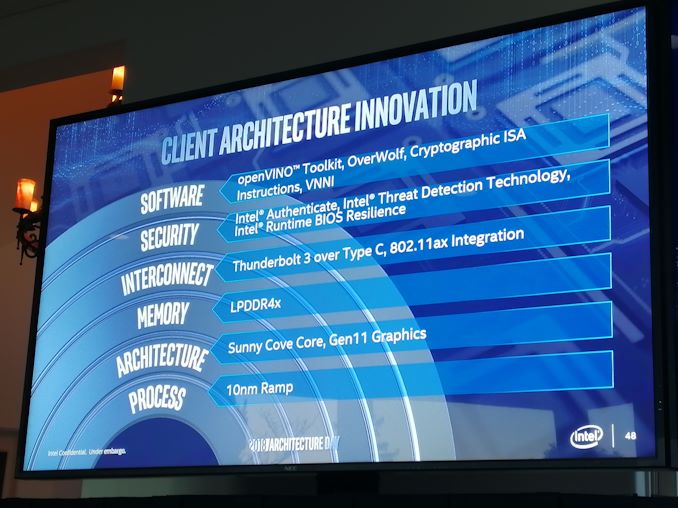
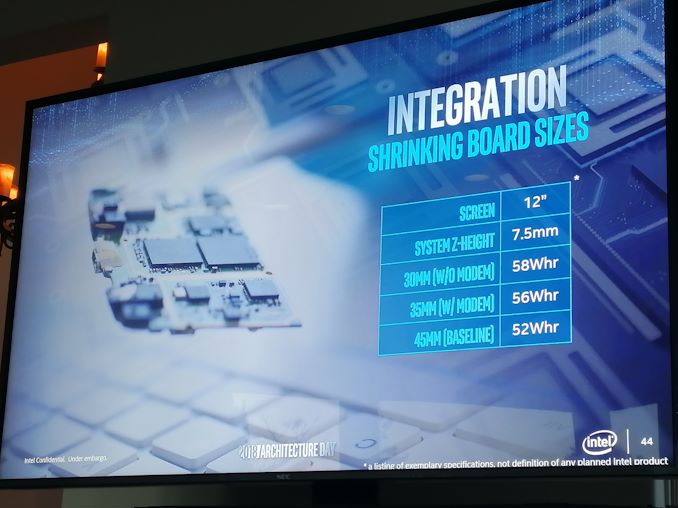
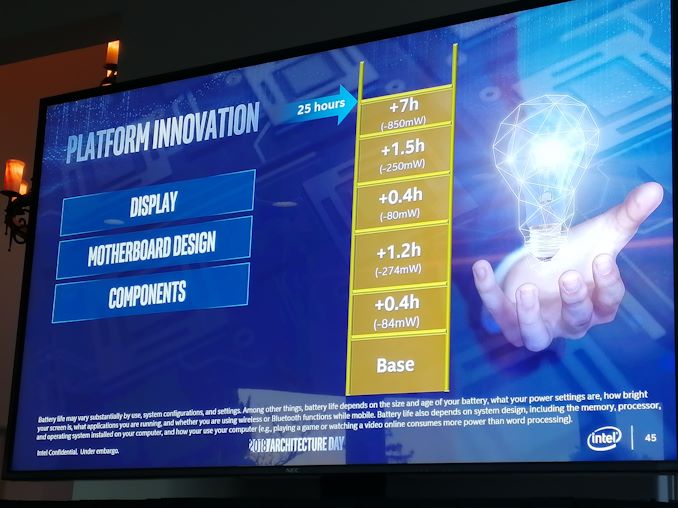
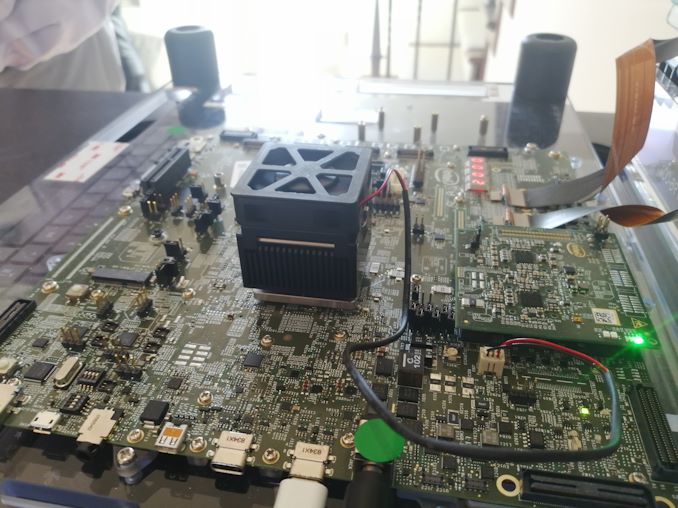









60 Comments
View All Comments
TheJian - Monday, January 7, 2019 - link
"The fact that Intel has achieved HVM with *any* 10nm product" as quoted at wccftech.I call BS until I can buy a 10nm DESKTOP chip. This even, is only coming for xmas 2019? LOL. HVM is I can BUY TODAY, or you're lying. I think they can do ONE chip, this one, which I think is Ice-Lake U, so very small compared to desktops. Again, I call BS if they can't make a ~200-300mm^2 desktop. Not ANY chip IMHO if you choose a very small one to HVM and then only for xmas, so just starting today even for the small chips? Is it even HVM yet for this one? Xmas is 12 months away, you only need to pile up a launch for a few months, so should be in a box by sept, back to school etc. If it's xmas I think this is just trying to stop shares prices from dropping due to yet another 10nm delay speech. Either way, 10nm hopes are now 2020 I guess for us desktop people, or do like me and buy 7nm AMD this year ;) I really doubt Intel 10nm will be much better if at all, than TSMC 7nm and 5nm TSMC a year later...LOL. Intel better hurry with 7nm or they've lost the fab race IMHO (said they were losing it 5yrs ago many times, here anandtech, seekingalpha etc). Good for AMD, but bad for America as I don't really want china/arabs winning fab wars vs. america.
I'm really hoping AMD can put out a great 12core (main desktop), and buy a few 8 core apu for HTPC's for xmas (will upgrade board/mem/apu at xmas in 2-3 htpcs). Get 7nm out the door amd, and you have 2-4 cpus sold to my family :) I'm not waiting for 10nm Intel with more mitigations slowing me down again and probably still not solved in hardware totally. AMD has issues too, but more of them require you to be AT the desk to do damage, where with Intel you can do a lot of damage remotely.
"greater execution capability is now part of the architecture"
This whole speech seems like no info. What the heck is this? Are you saying you build worse execution capability into chips on purpose before? Is this not the goal of ALL cpu/gpu enhancements? More execution ability? I'm confused...LOL. I've heard of TRUSTED execution, but what is "greater" execution ability built in? You google that you get nothing. I'm feeling like 2019 Intel CES speech was a repeat of 2018 (nothing burger). Until I see a 10nm desktop, whatever man.
https://www.anandtech.com/show/13774/intels-keynot...
As anandtech says, these are the smallest chips to balance yield/cost. So HVM with terrible yields then? So you have to go SMALL...Is it HVM for ALL if you can't do anything but PUNY chips or they are too expensive to ship? TSMC has HVM for A12x (122mm^2), which is probably in the realm of the size of this chip based on previous die sizes of U chips. Again, not impressed Intel. Wake me when you put out 10nm desktops above 200mm^2 at least and AMD's coming cards have chips in the mid 200's or so it seems again at 7nm TSMC.
"Terms like ‘5G’ and ‘Artificial Intelligence’ are only going to become more ubiquitous through 2020 and beyond, so Intel is jumping on it today."
You're a little late, as everyone else is ALREADY here. See Nvidia etc. Is Intel available today, or 2020?
"With Project Athena, Intel is going to discuss with OEMs, with partners, customers, software developers, etc. what they need in order to enable these new terms to provide a good user experience."
"As this is a new program based in aspirational discussion followed by execution"
Yeah, like I said, nothing burger again. We're about to "discuss" what we might JUMP ON, at a later date when we "EXECUTE" what we "DISCUSS" with oems etc...LOL. How about EXECUTING on some 10nm DESKTOP chips? Never mind, I can just buy AMD 7nm 12 core this year and a gen I won't mind gaming on finally ;) I just hope AMD prices to them make some NET INCOME finally so they can R&D 5nm etc going forward. You can't do that on <100mil a quarter vs. NV (1B a Q) or Intel (never mind...LOL). Price LIKE YOUR WINNING AMD! Not like some discount 2nd rate Intel. IF you win nearly every benchmark at 7nm vs. Intel 14nm (the case for another year probably if they release shortly), PRICE ABOVE Intel. PERIOD. No point in discounting chips if you're WINNING watts/perf. Make hay while the sun shines! Sell to the RICH or continue to be POOR AMD. Ask NV/Intel what this means (HEDT, Titan, 2080ti etc).
CajunArson - Monday, January 7, 2019 - link
Wow you are clearly butthurt and scared.Anyway, instead of a wall of text here's a fact: if you dropped Intel's non-volatile memory division.. you know the division that makes the "failed" Optane into AMD, then it would be by far the largest and most profitable segment of the company.
And at Intel they call that division a "side hustle".
TheJian - Tuesday, January 8, 2019 - link
Not even sure what you mean by butthurt or scared? Irrelevant post. How about attacking the data? Typical Democrat post ;) Attack data, not the person. Not sure what Optane has to do with AMD, but I do own micron stock (and AMD...LOL), and am UP double (16.77 avg price of my shares), so I'll be laughing when 3dxpoint crap hits next year anyway :) MU/NVDA both great pics (1/2 off in both vs. recent highs), and AMD though risky, not really until Intel gets it's act together in the next 12-18 months. IE, 7nm vs. Intel 14nm is a loser for Intel until then if AMD gets them out soon that is, and never mind what happens with 64core 7nm vs. Intel 14nm 48 core. That's a bloodbath for Intel IMHO, and don't think 10nm Intel will fix it. I think this brings you even maybe, but 5nm right after on TSMC anyway maybe even beating Intel again to 7nm so keeping the lead. Time will tell.https://en.wikipedia.org/wiki/File:Graham%27s_Hier...
Please read the pic, then understand how to respond :) You don't know how to debate. You lose.
SpartanJet - Tuesday, January 8, 2019 - link
I think you meant typical republican post. Lie about everything and hide your head in the sand when science is involved.PeachNCream - Tuesday, January 8, 2019 - link
Not sure Anandtech's article comments are an appropriate venue for something involving American politics.FunBunny2 - Tuesday, January 8, 2019 - link
trade wars and IP fights and the like aren't??? of course it is. there's a reason Apple's China Syndrome has crashed and burned. much of that is due to politics: Apple decamped production to China, and other off-shore facilities, because politics encouraged it. politics matter.PeachNCream - Wednesday, January 9, 2019 - link
There are other places for that kind of discussion.TheJian - Wednesday, January 9, 2019 - link
You just proved my point. Blah, blah, blah, I hate you, you suck, you didn't say it right, you lie, blah blah, I have no data, but again, you suck and I'm right...LOL. That is all I'm hearing as you said nothing more.Please be more specific. What science is ignored? When did the topic change to science anyway (I’m talking process and failed chips)?
OK, as a republican (er, only because I have to register with someone, to vote in a presidential primary), what in my post was a lie?
How about you attack the data in MY post instead of shifting topics like all dems do when faced with an actual argument. I’m supposed to defend republican posts I’m not even aware of now? I pointed out exactly what he did and BTW he did nothing but change topics to irrelevant junk not remotely related to my post regarding Intel’s failures in chips/process. However, I addressed his irrelevant comment anyway…LOL.
How'd we NOW get to science and lies (is that relevant to my post?)? The OP responded to my post with "butthurt and scared"...WHAT? Again, this is the point I made with my "typical dem post" reply. ;) The OP responded to me dismantling the article, with, but but but, if Optane (who brought that up?) was part of AMD it would be the largest and most profitable segment of that company. How did we go from “failure of Intel process, and defective chips” to “er uh, that memory tech Intel has (that they’ve failed to successfully launch too BTW), is awesome and AMD sucks because they don’t have it”? Again, he proved my point. I have no comment on what you ACTUALLY said, so here’s my shiny object…LOL. Comic, you just did the same thing. I can’t make an argument, so er, uh, you lie and don’t like science! LOL.
Read my post you responded to, where I gave a link that tells you how to form an argument so we can have a reasonable debate about something, rather than crap like you posted which only serves to PROVE my point yet AGAIN. You have not provided an argument (rather an opinion backed by nothing), and thus have nothing for me to debate...
Can you provide an actual argument on science or lies? I see nothing. Then again, that isn’t even addressing my post either (which the OP ignored too), but I’d like to see you actual attempt to make a REAL point…LOL. Please stick to content in MY post, as it's not my job to defend OTHERS not relevant to what I said anyway :)
sorten - Monday, January 7, 2019 - link
Too much shouting.TheJian - Tuesday, January 8, 2019 - link
https://en.wikipedia.org/wiki/File:Graham%27s_Hier...Figure out how this comment crap works ;) Who cares how I say it, it's the data that counts. You remind me of crazy AOC comments like:
“I think that there’s a lot of people more concerned about being precisely, factually, and semantically correct than about being morally right,”
Uh, yeah, I don't give a rats behind about what people think about my MORALS (or shouting...LOL). I care about getting the DATA and FACTS right. You should too, regardless of how it's said, or how the text looks. Be thankful I didn't cap it all...ROFL.